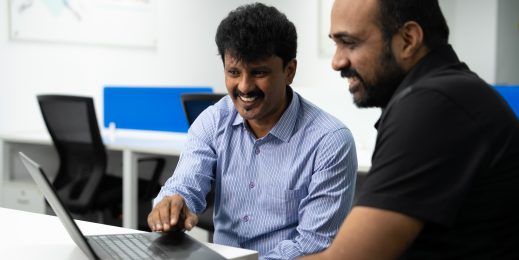
Transforming by building tech intensity – YES BANK charts a new wave of digital banking
In conversation with Anup Purohit, Chief Information Officer, and Ritesh Pai, Chief Digital Officer, YES BANK
Technology adoption, building technology capabilities and trust are vital components of tech intensity–the potential of companies to jump start their growth by not just adopting technology, but by building their own technology capabilities. In today’s era when every company is on the path to becoming a digital company, a tech intense transformation at YES BANK, with its early bet on cloud and AI, is helping it set itself apart from the competition.
YES BANK is also utilizing AI to deliver new customer experiences like YES ROBOT, which is setting new standards for the Indian banking ecosystem by offering more than 25 banking services including the ability to book fixed deposits and transfer money on social media platforms.
“New-age customers compare banking apps with other tech-centered, non-banking apps and demand the same convenience. It all boils down to coming up with more customer-centric solutions, rather than product-centric solutions with AI and cloud,” says Ritesh Pai, Chief Digital Officer, YES BANK.
“The cloud brings a lot of agility and flexibility in terms of quick turnaround, over otherwise time-consuming processes. I’ve always believed that the cloud is more secure than on-premise data centers,” adds Anup Purohit, Chief Information Officer, YES BANK.
We caught up with Purohit and Pai at YES BANK’s headquarters in Mumbai, where we touched upon the bank’s cloud and AI journey, their vision of the future of digital banking and their journey to becoming a technology company by building its own unique solutions. Here are some edited excerpts from our conversation.
What is the role technology can play in democratizing banking?
Anup Purohit: In its truest sense, digital banking would be successful only when everyone with a feature phone can access the same banking applications as a customer with a smartphone. With the ratio of smartphone penetration to feature phone penetration at around 40:60, the need of the hour is to help the underserved populace experience mainstream banking with technology.
For those at the lower rung of the pyramid, the future is all about leveraging technology to bring a larger chunk of the populace under the umbrella of banking. For those at the middle and this accounts for a significant fraction of the pyramid, it is all about increasing the convenience and security involved in transactions. For those who are already at the top of the pyramid, digital banking means seamless round-the-clock interactions through any channel, regardless of whether they are at home, office, or driving a car. Also, technology is already playing a crucial role in financial inclusion and serving un-banked and under-banked masses with different banking services.
Ritesh Pai: When YES BANK commenced operations, other private banks already had a 10-year head start. Technology has been our key pillar of strength and strategic advantage in closing this gap and providing superior banking services to our customers. Here at YES BANK, technology is a way of life and not a force-fitted component on top of legacy systems. We introduced several industry-first features, such as second factor authentication, personal finance management tool and banking on feature phones. There were challenges like latency and network issues, but our vision on technology and a clearly defined roadmap helped us remain steadfast in our efforts to stay ahead of the curve and democratize banking.

Tell us about YES BANK’s cloud and AI journeys?
Anup Purohit: We started our cloud journey by migrating some non-core applications like HR portals and learning management systems to the cloud; picking up those applications which did not have customer information. When we considered moving some of the sensitive applications to the cloud, the first thing we did was to understand the architecture and security aspects from the cloud service providers.
In the process we also worked with Microsoft architects, who helped our security and infrastructure teams to gain a deep understanding of Azure. We worked with Microsoft and OEM application owners, to be cloud-ready for certain applications. In parallel, we started picking up our workloads on the cloud and looked at SharePoint and developed workflow systems.
We also looked at some of the critical applications like statement printing, which have an elastic workload. By the end of the month, the volume multiplies exponentially than the beginning of the month and that was a volume our on-premise systems would struggle to keep pace with. Today, no matter what the workload is and no matter how high the volume is, cloud infrastructure takes care of it.
As far as AI is concerned, our intent was to develop our own strengths. In conversational banking whatever device the customer uses, we wanted YES BANK to have best of the breed Natural Language Processing (NLP) engine to serve our customers with best conversational experience. We wanted something that was robust enough to understand customer inputs from any channel and then initiate actions depending on the commands. Today, with Azure AI, we are doing that. At the same time, our platform is capable and future-ready for leveraging any cognitive capabilities which suits our requirement and best fit for the use case in hand.
Ritesh Pai: With AI we want to take a sniper approach. How do we differentiate every single customer from millions of others and offer a proposition that he or she will like at the right time and right place. From a base of 2.8 million customers, how do we identify the ones in need of a personal loan right now and service them? Mass customization is the key to unlocking significant opportunities in future and can be tapped only through technologies like AI and Blockchain. We started our AI journey in 2016 and I think we now have enough experience and learnings in place, to start the next jump.
Another branch of AI is Robotic Process Automation (RPA), which unloads the burden of repetitive, voluminous transactions like reconciliations and salary payments. Such processes can be automated through RPA. Having said that, a lot of client engagement activities or the solicitation of certain complex financial services are best done by a human. Also, a large section of the population prefer financial services to be rendered in a certain way and they would continue to function in an assisted mode.

What makes you so bullish about cloud and AI?
Anup Purohit: From a domain point of view, cloud is an excellent platform. The capital expenditure is not much, and you can go live and start working on the technologies you need at the click of a button. Having said that, I think it is natural for legacy sector players like banks to take time to assimilate security-related details and then make a gradual move to the cloud.
I have always believed that the cloud is more secure than on-premise data centers, which is why our intention was to understand the cloud architecture and get into the cloud with an open eye. We evaluated other providers, but it was Microsoft that went a step beyond in helping us everything about the service architecture and how we can tweak things around if we want to share some load on our proprietary gateway.
Ritesh Pai: New-age customers compare banking apps with other tech-centered, non-banking apps and demand the same convenience. It all boils down to coming up with more customer-centric solutions, rather than product-centric solutions with AI and cloud. Users may not differentiate between an application that has to operate within regulated framework vis-a-vis one that is purely into customer acquisition or a different line of business. Even when we are a highly regulated industry, modern customers expect similar convenience, engagement, and feature richness in our digital solutions as those of non-banking popular apps.
Considering these challenges, we started exploring the possibility of rendering banking services to our customers in the medium/mode of their choice, rather than expecting them to migrate to our real estate / digital properties.
We partnered with corporates, e-commerce firms, cab aggregators, and business correspondents that started using our APIs for varied purposes such as integrating payments into their services. Then, we went on to build some capabilities on social media platforms, because we can’t expect new-age customers to log out from apps that they are already hooked on to. This is where Azure AI-powered API banking works in products like YES ROBOT.
We firmly believe that the future lies in conversational banking. It could be chat, voice and rendering some of these services through IoT channels. Everyone wants to do things from the comfort of his or her home or office and expects things to be easy, without being prompted to key in passwords repeatedly. That’s where AI comes in handy because a whole lot of algorithms can be built, without compromising on security protocols.
A lot of this sounds like what one would hear at a technology company and not a bank.
Anup Purohit: At YES BANK, we consider ourselves a technology company in the banking business because we have that kind of skillsets. While we may not have hundred percent of the capacity, we have the capabilities. We just need to augment the capacity and then partner with other companies to build our own Intellectual Property (IP).
For the first ten years, we were almost outsourcing-led organization and the technology was to a great extent outsourced. During the next phase, we decided to put an end to our dependency on others in many of the areas and devised strategies that prioritized the development of our own IP.
While considering our AI journey, we were clear that we cannot hire data scientists in abundant who are specifically suited to our needs. Instead, we began recruiting the brightest students from top-notch engineering colleges, assigning them innovative projects, bring them up to the speed and up-skill them to decent data scientists as quickly as possible. Voice banking is once such project we assigned to students and they came up with a fantastic solution, which will go live soon. We realize this is a great way for us to build our capabilities and for employees to develop new skills.
Ritesh Pai: A lot of players adopt technologies merely to stay relevant. But I think you can add value and create more channels of revenue with right implementation and relevant use cases. It’s a given that technology is here to stay, but your success depends on how you harness it in the right way and make it work for you.
















